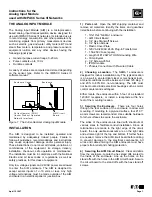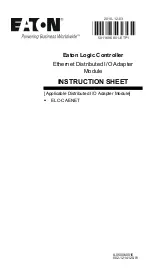
LAMBDA 10-2 OPERATION MANUAL – REV. 2.04 (20120224)
41
there. For a description of an alternative method of remote shutter control, see the
description of the Dedicated TTL Line
Dedicated TTL Line
Dedicated TTL Line
Dedicated TTL Line later in this chapter.
Batch Transfer of Commands via the Serial Port:
Batch Transfer of Commands via the Serial Port:
Batch Transfer of Commands via the Serial Port:
Batch Transfer of Commands via the Serial Port: In order to quickly transfer commands for
both wheels and shutters, you should use the
BATCH TRANSFER
method. The controller
will wait for commands for both wheels and both shutters before executing any of those four
commands.
First send the
BATCH TRANSFER
command, 223, and then send the four commands for the
2 wheels and the 2 shutters. Send the desired commands in the following order:
1.
223
2.
Shutter A command
3.
Shutter B command
4.
Filter/Speed/Wheel A command
5.
Filter/Speed/Wheel B command
The controller will echo each command as it is sent. Once the controller has received the
BATCH TRANSFER
command, the unit will not respond with a carriage return or
mechanical action until all four commands have been received. The carriage return will be
sent when both wheels and shutters are in the state required by the commands. The batch
transfer command must be sent each time a new batch of commands is sent. Once the batch
commands have been executed as signaled by the carriage return, individual commands or
additional batch commands may be sent.
With this approach, the five commands can be passed in less than 6 milliseconds. The values
of each of the four types of command are distinct, so the controller may be able to respond
correctly even if the four commands are sent in a different order. Sending the commands in
the correct order assures the best performance.
The controller will echo each command with a delay of about 1 millisecond. If your hardware
or software is not able to handle serial input and output at the same time, you may need to
wait for each echoed command before sending the next command. In this case, the time to
transmit the commands may increase to about 12 milliseconds.
4.4.4
4.4.4
4.4.4
4.4.4
Output Command Structure: Command Echo and <CR>
Output Command Structure: Command Echo and <CR>
Output Command Structure: Command Echo and <CR>
Output Command Structure: Command Echo and <CR>
With the serial interface, the LAMBDA 10-2 controller responds to each command by
echoing the command back to the host computer. This indicates that the command was
received and will be executed promptly. If the command sent is the same as the last
command received, it will not be echoed and the controller will take no action. Once the
command has been executed completely, the controller will send a character with the value
of 13, which is an ASCII CR (carriage return). In order to read the responses using
BASIC
,
you can use a statement such as:
IF LOC(1) > 0 THEN SerialInput$ = INPUT$(1, #1)
LOC(1) > 0 indicates that characters are waiting in the received data buffer. INPUT$(1, #1)
reads 1 character from the buffer, which is stored as SerialInput$. The following subroutine
could be used to hold the computer in a loop until the command is properly echoed.
COMMANDCHECK: IF LOC(1) > 0 THEN SerialInput$ = INPUT$(1, #1)
IF DATANUM = ASC(SerialInput$) THEN RETURN
GOTO COMMANDCHECK
















































